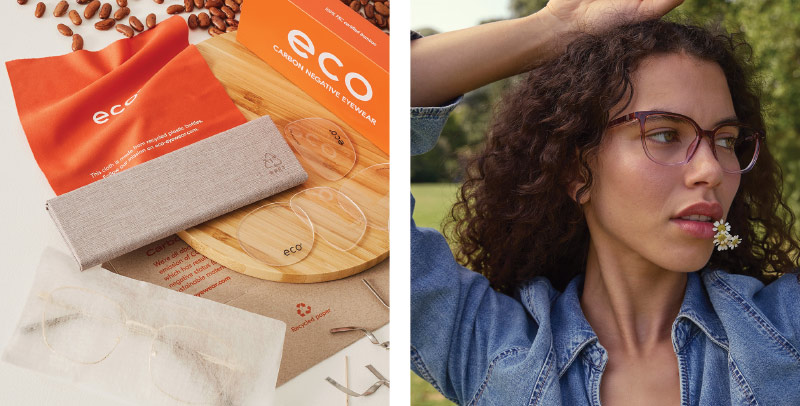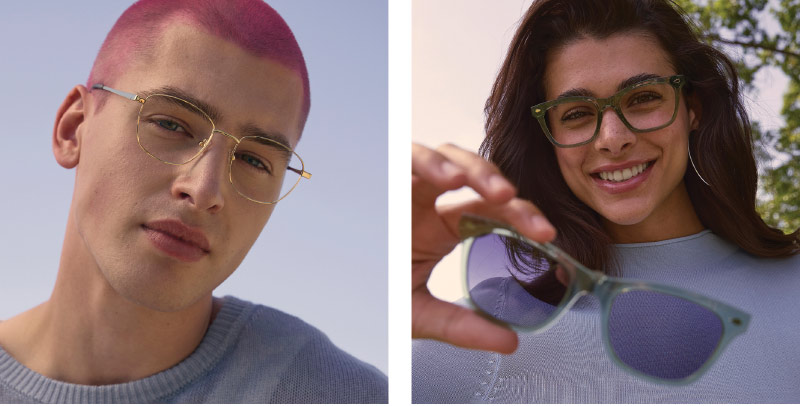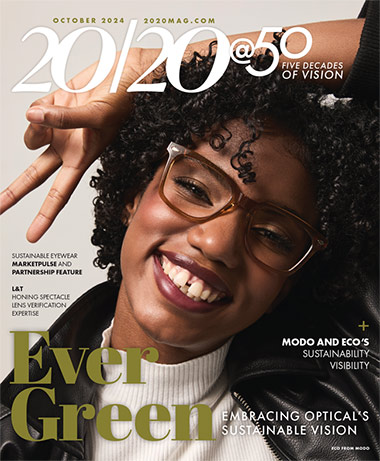

By Christine Yeh
In 2024, we had the opportunity to look back on 20/20’s coverage on a variety of eyewear categories as part of our 50th anniversary celebration. This month, we focus our sights on sustainable eyewear, one of the “greener” categories in our industry. Greener in more sense than one—it is still a relatively new category with more growth opportunities to be explored and of course, in the environmentally conscious sense.
The modern environmental movement began just a few years before 20/20 was founded. In 1970, the inaugural Earth Day was held, considered by many as the birth of this movement. Celebrated every year on April 22, Earth Day demonstrates support for environmental protection through education and activism. With the founding of Earth Day, support for protecting the environment and acknowledging the negative impact of climate change began to grow, but it wasn’t until a few decades later when this movement became a global effort. Legislation was enacted to address climate change, manufacturers in multiple industries began to make efforts to reduce their carbon emissions, recycling became a household activity, and calls for more sustainability in all facets of our environment began to grow. Some manufacturers and consumers were quicker to adapt than others. Admittedly, it took some time before the optical industry began to adapt. But later is better than never, and sometimes it takes one visionary to step up and take the initiative in setting an example for others to follow. Enter Modo.
In 2009, Modo introduced Eco Eyewear, a collection of frames bringing environmental responsibility to the forefront. Founder and CEO Alessandro Lanaro saw an opportunity to make a difference in the industry among the millions of corrective eyewear and sunwear users. Lanaro shared with 20/20 at the time, “The power lies with the retailers to make sustainability attainable for all, and that means offering a desirable, quality collection at a fair price.” The Eco debut collection utilized recycled stainless steel to create frames fusing fashion and sustainability for the stylish and earth-conscious consumer. To achieve a 360-degree approach to sustainability, it was important for Eco to repurpose, recycle or reuse materials through every step of the product life cycle, including the frame’s packaging. Each new pair also included a mail-in recycling kit allowing customers to donate unwanted frames to charities in developing areas of the world. Because sustainability goes far beyond using sustainable materials, it was also important for the company to demonstrate its social responsibility beyond using sustainable materials. With each pair of Eco frames sold, one new tree is planted in partnership with Trees for the Future, a non-profit organization that has been helping communities around the world plant trees since 1989. This initiative came to be known as Eco’s “One Frame, One Tree” program.
The following year, the Eco sunglass collection launched, featuring sunwear styles made with 95 percent recycled stainless steel and plastic. It was clear this new approach to eyewear was beginning to gain traction. “Consumers are paying more attention to what companies stand for because they know they can make a significant difference by purchasing products made of recycled materials,” Lanaro remarked during that time. Building on that awareness, in the years that followed, a children’s collection was also introduced, along with continuous updates on the Eco optical and sunglass styles, and the introduction of Biobased, Eco’s plant-based material derived from the oil of castor seeds.
Today, Eco continues to explore ways to create sustainable eyewear with environmentally conscious materials and methods. Currently the frames in Eco’s portfolio are made using three main material categories: plant derived Biobased material, recycled metal and ocean plastic waste. Expanding on its 360-degree sustainable approach, Eco incorporates green thinking into every element of its business. Frame cases, packaging, demo lenses, cleaning cloths, displays and marketing materials are all made with recycled materials. The company also notes that Eco was the first eyewear brand in the industry to address single use waste from frame poly bags by creating the first sustainable alternative—biodegradable bags made with 100 percent corn starch.
Beyond Eco’s manufacturing and business practices, the company remains staunchly committed to social responsibility and emphasizing its social purpose initiatives. The One Frame, One Tree program has planted over 3.8 million trees to date, absorbing 233 million kilograms of carbon dioxide with over 1,160 acres of land restored, helping developing communities and improving the livelihood of families in those communities. In 2023, Eco became one of the first carbon negative brands in the world, meaning that its efforts in reducing carbon emissions have cleaned out more carbon dioxide than the amount of eyewear it produces. The company also continues to sponsor beach and river clean-ups around the world and partner with organizations such as Waste Free Oceans to divert waste from the ocean.
Consumer awareness for environmental sustainability has increasingly grown in the past decade, and more eyewear manufacturers began to acknowledge the necessity to join the sustainability movement. Some companies introduced their own sustainably sourced eyewear styles, while others began to use Eastman’s Acetate Renew, a sustainable alternative to traditional acetate. Crafted in partnership with Mazzucchelli 1849 using recycled acetate scrap and carbon renewal technology, Acetate Renew is a cellulose diacetate composed of 60 percent bio-based and 40 percent certified recycled content. Eastman subsequently introduced Tritan Renew and Tenite Renew, providing even more sustainable material options for companies to add more sustainable frame and lens choices to their portfolios. Other sustainable efforts across the industry in the lenses and technology sectors have also risen as awareness continues to gain momentum.
With sustainability seeing promising growth in the optical industry, Modo continues to forge ahead with its sustainability goals, recognizing the impact Eco has made as pioneers of the sustainable eyewear movement. “We are feeling the responsibility of leading the sustainable eyewear industry by always staying innovative and resourceful in order to make a greater difference at every step,” Lanaro says in a 2023 interview with 20/20. When Eco reached carbon negativity that year, he shared: “It was a magical moment. Not only for me but also for the entire Modo team responsible for making this happen, and for all the customers and final consumers making this possible. Purpose is one of our three pillars (design, innovation and purpose). We feel so grateful to have started this journey the way we did and to enjoy these amazing results. However, we really believe that we have just started and that so much more work has to be done. We are so excited about the future.”
Once considered a niche category, sustainable eyewear has earned a critical spot in 20/20’s editorial coverage as we committed to shining a brighter light on its vitality and highlighting the voices of those who are playing active roles in leading with social responsibility. Rebecca Giefer, CEO of Modo Americas, shares further thoughts on Eco’s role and the future of this category.

20/20: Eco has been able to achieve carbon negativity and continues to set an example with social responsibility. Are there any opportunities that remain untapped and what do you think companies can be doing more of to elevate their sustainability efforts?
RG: There is always more we can do, and we will continue to challenge ourselves in every aspect of material innovation, sustainable packaging and the manufacturing process. We know that pioneering in the sustainable eyewear space inspires other companies to think in a more Earth conscious way. Even if the goal is not carbon neutrality, there are many smaller things that can be done to make a difference for our planet’s future.
Companies and brands can claim to be sustainable, but some customers want to see transparency for these efforts. How do you show your transparency and accountability?
Our websites, eco-eyewear.com and
modobiz.com, have materials about our commitment to reducing carbon emissions. We include third party certifications and detailed reporting on Eco’s carbon footprint. A few years back, we produced a coffee table book on Eco’s impact, and we know it’s time to do that again with our latest efforts. It’s a great way to get content to our customer’s patients so they can understand the social impact of choosing Eco. We work with Trees for the Future (trees.org) where we break the cycle of hunger, poverty and environmental destruction in impoverished communities in both Africa and South America. Trees for the Future trains farmers in agroforestry and sustainable land use, so that they can grow vibrant regional economies, thriving food systems and a healthier planet.
Do you believe companies can collectively join to work together, share ideas and collaborate on sustainability for the greater good?
We welcome more participation in earth-friendly business practices—material sourcing, zero-waste manufacturing, renewable energy, transparent supply chains, local production, digital solutions and more. Sustainable manufacturing is not just about being efficient with materials, it’s about creating products that meet needs without compromising the ability of future generations to meet theirs.
For those manufacturers and ECPs who are still finding challenges in embracing sustainable eyewear, whether it’s selling or understanding its value, what advice or guidance can you provide?
For ECPs, it starts with education and social media because that is where many of us are consuming information. Eco’s marketing team curates a range of Eco content that can be used on our ECP partners’ social media platforms. This is an easy way to educate and inform current patients and attract new ones. For manufacturers, we see quite a few efforts that have great impact. Factories around the globe are prioritizing resource efficiency, waste reduction, water conservation and energy saving initiatives. Last but not least, it’s important to take initial steps forward and recognize that incremental changes can add up so it’s OK to start small.
Some people question how frames can be considered sustainable if they are still made from plastic, even though they were sourced from recycled and bio-based materials. What do you find is the best way to respond to that?
Our goal is to truly make a difference. We use recycled or bio-based plastics, ocean waste litter and recycled stainless steel—all of which reduces the need for new materials, curbs waste, saves energy and supports the circular economy. These materials significantly lower Eco’s carbon footprint that is then offset by tree planting with Trees for the Future.
Do you believe the next generations of consumers will embrace more sustainability in the future?
Yes. Consumers are more aware and educated than ever because they have more access to information than ever. We know people want to make earth-conscious purchasing decisions without compromising design or quality.
What are Eco's goals for the near future in growing the visibility
for sustainability?
Eco continues to innovate with materials, constructions and magnetic clips; the SS25 collection includes noteworthy Eco Active styles! Later this year, Eco will proudly achieve four million plus trees planted, and we’re working on a proper celebration for this special milestone. A huge thank you to our customers for making it happen! ■










